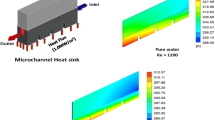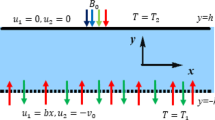Abstract
The following work experimentally and numerically investigated the thermal performance of a hybrid nanofluid, prepared by decorating a nanostructured aluminum oxide support with copper oxide nanostructures, in a flow system of porous open-cell foam metals. The porous medium was comprised of 6061-T6 aluminum with a porosity of 0.91 and a permeability of 9.54788 × 10−7 m2. Experiments were performed under variable heat flux, using a hybrid nanofluid consisting of a 0.1 mass% aqueous solution of CuO@Al2O3 nanocomposite particles 28 ± 11 nm in size. Thermal performance was evaluated with respect to the Nusselt number and the index of performance with pressure. Remarkably, the implementation of a copper oxide/alumina nanocomposite with the use of porously filled channels resulted in significant thermal enhancement (6–11%) relative to commercial alumina nanofluid, despite a total copper concentration of only 0.0001 mass% in the hybrid nanofluid. Increased performance is attributed to a combination of ultralow copper content and the approach to hybrid nanofluid design. Specifically, a small amount of copper significantly increased the local Nusselt number, indicative of superior heat extraction. At the same time, a numerical model of the system was also developed and agreed with experimental measurements within an error of 5%. Numerical results predicted a slightly higher pressure drop for the hybrid nanofluid, but also showed higher absolute pressures for the hybrid fluid all along the channel in the three-channel configuration. Simulation also produced an interesting discrepancy between the performances of the hybrid nanofluid as a function of heat flux, possibly related to different channel pressures inherent to the two heat sink models under investigation. This could point to a heightened pressure sensitivity of the thermal properties of hybrid nanofluids as well as a greater need to consider experimental design in the comparison of heat enhancement across nanofluidic systems. In terms of material design, decorating alumina nanoparticles with copper nanoparticles rather than mixing two individual nanostructured components appears to have been a beneficial strategy. The photochemical methodology used to prepare the nanocomposite material may also have improved thermal performance by yielding smaller (< 5 nm) copper oxide nanoparticles and provided access to the synergistic properties of a true nanocomposite material. This study demonstrates that heat enhancement by nanofluids can be achieved using a much smaller amount of copper than previously described in the literature and further highlights that synthetic methodology and material characterization can have a dramatic impact upon the performance of applied nanocomposite materials. Additionally, this work delivers a practical example of how progressive nanofunctionalization of materials can enhance thermal functionality of nanofluids.











Similar content being viewed by others
References
Suresh S, Venkitaraj K, Selvakumar P, Chandrasekar M. Synthesis of Al2O3–Cu/water hybrid nanofluids using two step method and its thermo physical properties. Colloids Surf A Physicochem Eng Asp. 2011;388:41–8.
Selvakumar P, Suresh S. Use of Al2O3–Cu/water hybrid nanofluid in an electronic heat sink. IEEE Trans Compon Packag Manuf Technol. 2012;2:1600–7.
Suresh S, Venkitaraj KP, Selvakumar P, Chandrasekar M. Effect of Al2O3–Cu/water hybrid nanofluid in heat transfer. Exp Therm Fluid Sci. 2012;38:54–60.
Takabi B, Shokouhmand H. Effects of Al2O3–Cu/water hybrid nanofluid on heat transfer and flow characteristics in turbulent regime. Int J Mod Phys C. 2015;26:155047.
Moghadassi A, Ghomi E, Parvizian F. A numerical study of water based Al2O3 and Al2O3–Cu hybrid nanofluid effect on forced convective heat transfer. Int J Therm Sci. 2015;92:50–7.
Ambreen T, Saleem A, Ali HM, Shehzad SA, Park CW. Performance analysis of hybrid nanofluid in a heat sink equipped with sharp and streamlines micro pin–fins. Powder Technol. 2019;355:552–63.
Devi SSU, Devi SA. Numerical investigation of three-dimensional hybrid Cu–Al2O3/water nanofluid flow over a stretching sheet with effecting Lorentz force subject to Newtonian heating. Can J Phys. 2016;94:490–6.
Sheikholeslami M, Arabkoohsar A, Babazadeh H. Modeling of nanomaterial treatment through a porous space including magnetic forces. J Therm Anal Calorim. 2019. https://doi.org/10.1007/s10973-019-08878-2.
Takabi B, Gheitaghy AM, Tazraei P. Hybrid water-based suspension of Al2O3 and Cu nanoparticles on Laminar convection effectiveness. J Thermophys Heat Transf. 2016;30:523–32.
Hamzah MH, Sidik NAC, Ken TL, Mamat R, Najafi G. Factors affecting the performance of hybrid nanofluids: a comprehensive review. Int J Heat Mass Transf. 2017;115:630–46.
Ramachandran R, Ganesan K, Rajkumar M, Asirvatham L, Wongwises S. Comparative study of the effect of hybrid nanoparticle on the thermal performance of cylindrical screen mesh heat pipe. Int Commun Heat Mass Trans. 2016;76:294–300.
Welsford CA, Delisle CS, Plant RD, Saghir MZ. Effects of nanofluid concentration and channeling on the thermal effectiveness of highly porous open–cell foam metals: a numerical and experimental study. J Therm Anal Calorim 2019;140:1–11.
Bumataria RK, Chavda N, Panchal H. Current research aspects in mono and hybrid nanofluid based heat pipe technologies. Heliyon. 2019;5:e01627.
Saba F, Ahmed N, Khan U, Waheed A, Rafiq M, Mohyud-Din S. Thermophysical analysis of water based (Cu–Al2O3) hybrid nanofluid in an asymmetric channel with dilating/squeezing walls considering different shapes of nanoparticles. Appl Sci. 2018;8:1549–612.
Tijani AS, Sudirman ASB. Thermos-physical properties and heat transfer characteristics of water/anti-freezing and Al2O3/CuO based nanofluid as a coolant for car radiator. Int J Heat Mass Transf. 2018;118:48–57.
Kahn A, Ali HM, Nazir R, Ali R, Munir A, Ahmad B, Ahmad Z. Experimental investigation of enhanced heat transfer of a car radiator using ZnO nanoparticles in H2O–ethylene glycol mixture. J Therm Anal Calorim. 2019;137:3007–21.
Lahari MLRC, Sesha Talpa Sai PHV, Swamy KSN, Krishnamurthy N, Sharma K. Investigation on heat transfer properties of water based TiO2–ZnO nanofluids. IOP Conf Ser Mater Sci Eng. 2018;455:12092.
Ahmadlouydarab M, Edadolahzadeh M, Ali HM. Effects of utilizing nanofluid as working fluid in lab-scale designed FPSC to improve thermal absorption and efficiency. Phys A Stat Mech Appl. 2020;540:123109.
Toghraie D, Chaharsoghi VA, Afrand M. Measurement of thermal conductivity of ZnO–TiO2/EG hybrid nanofluid. J Therm Anal Calorim. 2016;125:527–35.
Babar H, Ali HM. Airfoil shaped pin–fin heat sink: potential evaluation of ferric oxide and titania nanofluids. Energy Convers Manag. 2019;202:112194.
Esfe HM, Saedodin S, Yan W, Afrand M, Sina N. Study on thermal conductivity of water-based nanofluids with hybrid suspensions of CNTs/Al2O3 nanoparticles. J Therm Anal Calorim. 2015;124:455–60.
Pacioni NL, Pardoe A, McGilvray KL, Chrétien MN, Scaiano JC. Synthesis of copper nanoparticles mediated by photogenerated free radicals: catalytic role of chloride anions. Photochem Photobiol Sci. 2010;9:766–74.
Hodgson GK, Impellizzeri S, Scaiano JC. Single molecule study of samarium oxide nanoparticles as a purely heterogeneous catalyst for one-pot aldehyde chemistry. Catal Sci Technol. 2016;6:7113–21.
Hodgson GK, Scaiano JC. Heterogeneous dual Photoredox–Lewis acid catalysis using a single bifunctional nanomaterial. ACS Catal. 2018;8:2914–22.
Acknowledgements
The authors acknowledge the financial support of the National Science and Engineering Research Council of Canada (NSERC) as well as Ryerson University. S. Impellizzeri and G. K. Hodgson also acknowledge the support of the Ryerson University Faculty of Science Dean’s Research Fund.
Author information
Authors and Affiliations
Corresponding author
Additional information
Publisher's Note
Springer Nature remains neutral with regard to jurisdictional claims in published maps and institutional affiliations.
Rights and permissions
About this article
Cite this article
Plant, R.D., Hodgson, G.K., Impellizzeri, S. et al. Experimental and numerical investigation of heat enhancement using a hybrid nanofluid of copper oxide/alumina nanoparticles in water. J Therm Anal Calorim 141, 1951–1968 (2020). https://doi.org/10.1007/s10973-020-09639-2
Received:
Accepted:
Published:
Issue Date:
DOI: https://doi.org/10.1007/s10973-020-09639-2




